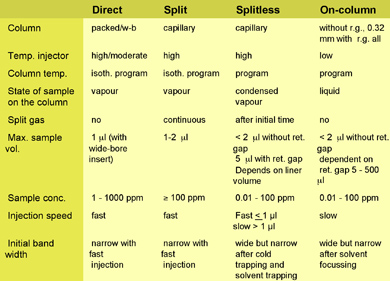The GC injector may seem a simple device. It is, however, a complex part of the entire GC system and has four important functions:
| |
Although there are some small differences in design, most injectors of various manufacturers are more or less the same.
The injection port for the sample is attached to a (heated) injector block. A septum seals the system at the injector side. A liner can be inserted into the injector block and installed by means of a nut and a ferrule. The liner operates as the evaporation chamber of the sample and the place where the column can be connected. The injector is connected to the column by means of a nut and a ferrule.
Depending on the amount and type of sample, as well as on the dimension and type of column, various types of injector are available:
- Direct injector: This injector is used for packed columns and wide-bore capillary columns. It is used for liquid samples. These samples can be pure liquid components or solutions of liquid and/or solid samples. Direct injection is practically always carried out at high temperatures and therefore a temperature control unit is required.
- Split injector: This is the most universal and most widely used injector for capillary columns. The split injector is derived from the direct injector and is also based on rapid evaporation.
- Splitless injector: This type of injector is used for highly diluted samples (trace injection).
- Cold on-column injector: This injector is used for direct injection of liquid samples onto capillary columns.
Comparison of GC injectors
 Did you ever try to explain separation to your employees or students? Well, try no more: Lee Polite did it for you in a way which is hard to beat. We will open up one example of his whiteboard class.
Did you ever try to explain separation to your employees or students? Well, try no more: Lee Polite did it for you in a way which is hard to beat. We will open up one example of his whiteboard class. 




